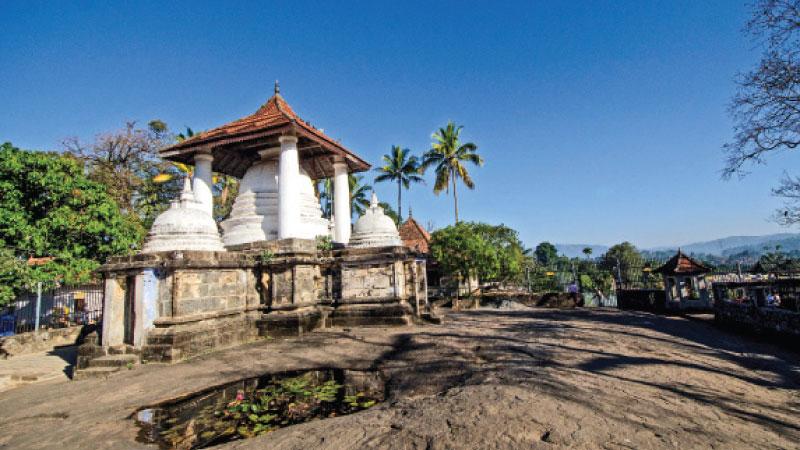
The cry of birds shatters the morning silence. Like a ghost in the mist, a grey colour granite structure hovers over the rock cliff and the mist wreathed surroundings. I waited at the Gadaladeniya temple till the sun came out dispersing the thick mist and paving the way for a blue sky. 
The Gampola kings had given prominence to Buddhism mixed with Hindunism, and built their temples and palaces on top of the rocky outcrops in their kingdom. The Gadaladeniya Temple, built on a rocky cliff, profits from its exceptional location.
Ancient vihara complex
The ancient vihara complex at Gadaladeniya covers the stone platform spreading from North to South. There are several roads leading to the city. A visitor arriving from the direction of Colombo having passed Kadugannawa and the township of Alakolanga will reach the Embilimigama-Daulagala road. The vihara can be observed over a stretch of rock platform.
The stone building erected in 1344, according to an inscription, is topped by a dome in the form of a dagaba. Another small dome adorns the adjoining devala. Hindu influence is obvious in the construction of the temple. The stone entrance is finely sculptured and the steps are decorated with a frieze depicting dancers and drummers.
 |
| The main image house with the gold-plated Buddha statue |
 |
| Inside the small image house |
The temple pillars, each one treated differently, are probably the work of several artists. The shrine room houses a gilded statue of a seated Buddha, surrounded by statues of the standing Buddha which bears South Indian sculptural features.
The Gadaladeniya Temple had been built during the reign of King Bhuvanekabahu IV (1341-1351 AD).
The shrine
The shrine room at Gadaladeniya had been built in accordance with the Indian Vijayanagar architectural style. According to the Gadaladeniya inscription the devala at Gadaladeniya had been constructed for the protection of the vihara.
The shrine rooms are constructed out of dressed stone and symbolise a happy blending of Hindu and Buddhist architectural patterns in one monument. It has the appearance of a three-storied building. The shrine room had been on the lower terrace. The devala of the deity Upulwan has three segments designated as 1. Hevisi Mandapaya (drumming hall) 2. Antaralaya (inner chamber) and Arbha Vimanaya (inner mansion). The plan of the shrine room is unusual.
A gigantic wooden door in the image house opens in two halves and has elaborate paintings and the door frame also contains beautiful carvings. At the foot of the steps to the main shrine there is a moonstone and two Gajasingha (elephant-lion) balustrades.
A wooden carving of this mythical being is found on a wooden pillar at the Embekke Devale as well. In the foreground of the image house, one can see a somewhat big dagaba placed at a height of 40 feet with four accompanying miniature dagabas around it with cells.
Four gods
They are said to be suggestive of four gods protecting the big dagaba. Inside the chambers of this structure are several miniature statues of the Buddha and faded murals. The roof above the dagaba has ensured that it can stand the test of time through centuries. The metres-long stone step pathway up to the temple from the western side looks magical in the morning. The Gadaladeniya Temple and the ancient Bodhi tree are beautifully lit up at twilight along with the mist laden mountain ranges.
